hankyoreh
Links to other country sites 다른 나라 사이트 링크
BTS' use of sign language in "Permission to Dance" music video draws international praise
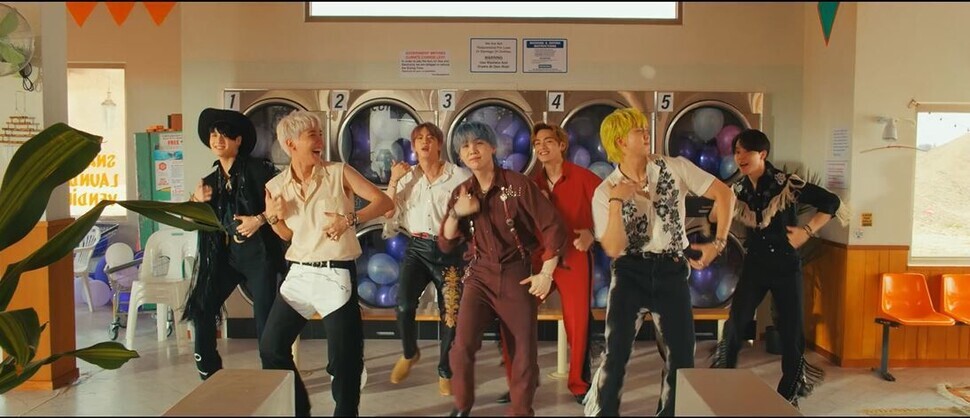
The BTS choreography that has been blowing up on social media recently started from one question: What sort of extra-special performance could the group stage to communicate a message of hope?
The significance of the choreography helped amplify the song's message, which is about everybody staying strong amid a pandemic situation that has lasted for well over a year. The sign language choreography appears in "Permission to Dance," the new track released by BTS on Friday.
In the final part of the song, where members all sing "na na na," the group performs choreography that incorporates the signs for "enjoy," "dance," and "peace."
"Enjoy" is expressed by a gesture in which the hands are moved up and down over the body in a scratching gesture with the thumb extended and the other fingers half curled. "Dance" is a gesture where two fingers on the right hand move left to right over the "stage" represented by the left palm, while "peace" is a "V" sign with both hands.
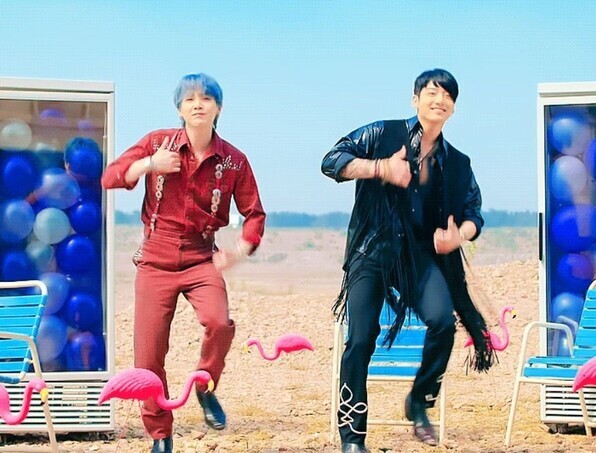
The concept of the song is a message announcing the end of the COVID-19 pandemic, as the BTS of the future releases purple balloons for those of us living through 2021. While there had been some concerns that the meaning might not come across because the signs had to be performed while the members were moving around dancing, the group said it wanted to thoughtfully convey a hopeful message.
To ensure the well-intended choreography did not get distorted, the BTS members and their choreography team took extra care with accuracy in their signs.
"After choosing keywords and symbolic gestures, we turned that into choreography, and we went through a process of holding many discussions with experts [including deaf people and sign language interpreters] to make sure the meaning was coming across clearly," said Big Hit Music, BTS' entertainment company. In effect, the choreography was a collaborative creation.
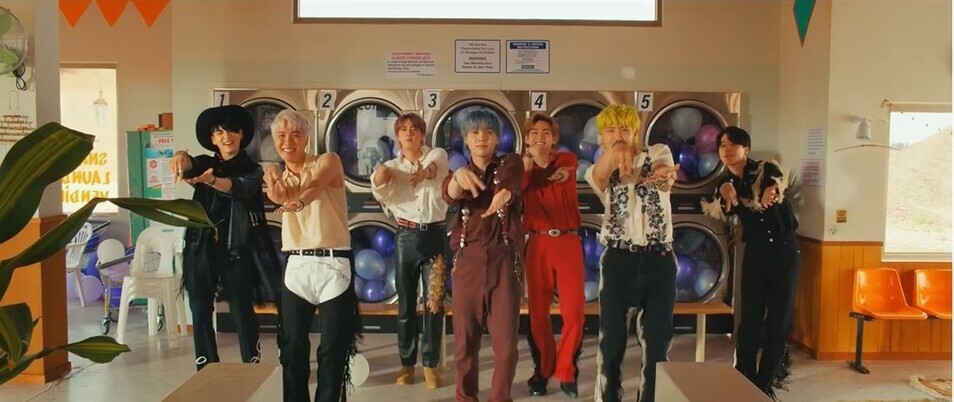
In addition to the accuracy of the gestures, the members took particular care with their facial expressions. The experts they spoke with talked a lot about the importance of such expressions.
For example, the sign for "enjoy" also conveys the sense of "welcome." To bring across the lyric about "enjoy" to deaf fans, the members have to really signal the enjoyment with their faces.
BTS' sign language choreography has moved deaf communities around the worldHamonthly, a YouTuber who is deaf, commented on her channel that facial expressions "are the most important thing in sign language."
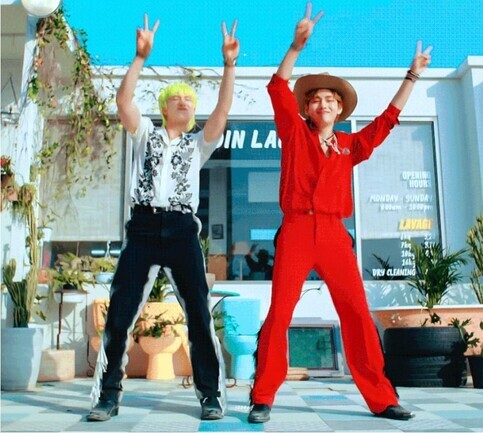
"BTS did a really good job of expressing an energetic feeling and faces of enjoyment," she added.
The extra efforts have moved many people around the world. On social media, deaf users have been posting a number of videos where they dance along with the sign language choreography.
"My cousin watched the video and was so happy, saying, 'Look, they're telling me to dance.' I've been crying after hearing that," read one social media message that has drawn attention recently for its heartwarming story.
Members of Korea's deaf community have also talked about the song's choreography. Kim Dong-ho, a sign language interpreter for COVID-19 briefings by the South Korean government, said, "Some deaf people saw it first and shared the video with me."
By itself, the use of sign language in choreography to express a message of oneness was not particularly special.
"To deaf people, music is one of the most distant genres in terms of culture. There's a cultural distance that means you have to go through another step to understand the lyrics and dance along," Kim said.
"Even to people who can hear the music, the sounds feel like vibrations that resonate," he added.
"But BTS helped to bridge that distance this time by using sign language in choreography that suits the lyrics so that deaf people can pick up on the meaning immediately and join in the enjoyment," he said.
The effort by BTS is even more significant at a time when deaf people who rely on lip-reading have been experiencing particular communication difficulties due to the mask-wearing requirements of the pandemic era.
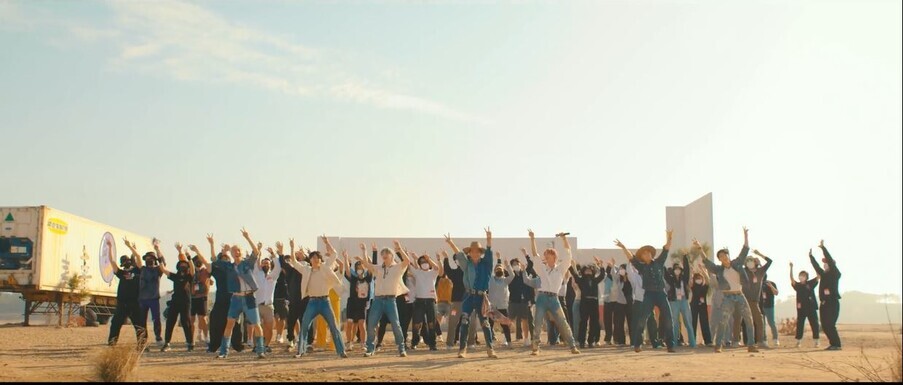
The situation draws attention to the role that celebrities perform, given the enormous influence BTS holds. Just as the historically themed TV series "Mr. Sunshine" encouraged teenagers to learn more about the history of Korea's volunteer soldiers, the "Permission to Dance" sign language choreography has proven effective in encouraging members of Army (The BTS fan club) to develop an interest in signing.
Army members have been discussing the meaning of signs on their blogs and sharing information from the National Institute of Korean Language's sign language dictionary. They also talk about how South Korea amended its law in 2016 to replace the generic term "sign language" with "Korean Sign Language," or KSL — extending recognition as a language in its own right.
The signs used in "Permission to Dance" come from International Sign (IS), which serves as a lingua franca along similar lines to English. Another tidbit that Army members share concerns the differences with the signs used in KSL to express concepts like "dance" and "peace."
"Everything that celebrities do can have a momentous impact," Kim Dong-ho said.
"You can sense the genuineness of their intentions in the way they used IS to share music with deaf people around the world. I'm grateful for the thoughtful consideration they have shown to the socially disadvantaged and to people who receive less attention," he added.
World Health Organization Director-General Tedros Adhanom Ghebreyesus also expressed his thanks on social media.
"As 1.5 billion people in the world are affected by hearing loss; sign language can help them to continue enjoying music which can bring joy to life," said in a tweet.
BTS also performed their song "Butter" in sign language during a May appearance on the US talk show "The Late Show with Stephen Colbert" on CBS. Member V signed "congratulations" to students graduating during the pandemic era.
It may be everyday acts like these that explain the particular meanings Army members are finding in the "Permission to Dance" video.
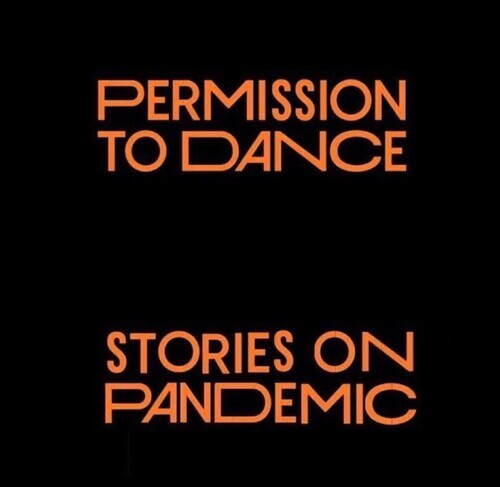
They've drawn connections between the laundromat that provides the video with its backdrop and the laundromat in "Spring Day," another BTS song with a message of hope. They've discovered that the title is an anagram for "Stories on Pandemic."
Big Hit avoided comment on the fans' interpretations, explaining only that "the items and setting were chosen to suit the music video script." July 9 was deliberately chosen for the release of "Permission to Dance" because it marks the eighth birthday of the fan club's adoption of the "Army" name.
All of the people who appear in the "Permission to Dance" video come out in masks. But they eventually remove them — a scene that many viewers said left them feeling overcome with emotion.

Will there ever come a day when we can remove our masks like the "we" in the video? "Permission to Dance" offers BTS' answer to that question: "We don't need permission to dance." Yes, they say — that day is coming.
The teaser video also has a scene announcing a BTS concert following the pandemic's end in 2022.
In a video interview Wednesday with Jimmy Fallon, host of the US talk show "The Tonight Show Starring Jimmy Fallon," BTS leader RM shared his hopes of doing a mask-free world tour. In particular, he said, he looks forward to yelling for fans at concerts to "scream" again.
By Nam Ji-eun, staff reporter
Please direct comments or questions to [english@hani.co.kr]

Editorial・opinion
![[Editorial] Intensifying US-China rivalry means Seoul must address uncertainty with Beijing sooner than later [Editorial] Intensifying US-China rivalry means Seoul must address uncertainty with Beijing sooner than later](https://flexible.img.hani.co.kr/flexible/normal/500/300/imgdb/original/2024/0517/8117159322045222.jpg) [Editorial] Intensifying US-China rivalry means Seoul must address uncertainty with Beijing sooner than later
[Editorial] Intensifying US-China rivalry means Seoul must address uncertainty with Beijing sooner than later![[Column] When ‘fairness’ means hate and violence [Column] When ‘fairness’ means hate and violence](https://flexible.img.hani.co.kr/flexible/normal/500/300/imgdb/original/2024/0516/7417158465908824.jpg) [Column] When ‘fairness’ means hate and violence
[Column] When ‘fairness’ means hate and violence- [Editorial] Yoon must stop abusing authority to shield himself from investigation
- [Column] US troop withdrawal from Korea could be the Acheson Line all over
- [Column] How to win back readers who’ve turned to YouTube for news
- [Column] Welcome to the president’s pity party
- [Editorial] Korea must respond firmly to Japan’s attempt to usurp Line
- [Editorial] Transfers of prosecutors investigating Korea’s first lady send chilling message
- [Column] Will Seoul’s ties with Moscow really recover on their own?
- [Column] Samsung’s ‘lost decade’ and Lee Jae-yong’s mismatched chopsticks
Most viewed articles
- 1[Editorial] Transfers of prosecutors investigating Korea’s first lady send chilling message
- 2[Exclusive] Unearthed memo suggests Gwangju Uprising missing may have been cremated
- 3[Column] US troop withdrawal from Korea could be the Acheson Line all over
- 4Xi, Putin ‘oppose acts of military intimidation’ against N. Korea by US in joint statement
- 5[Column] When ‘fairness’ means hate and violence
- 6[Editorial] Intensifying US-China rivalry means Seoul must address uncertainty with Beijing sooner t
- 7‘Shot, stabbed, piled on a truck’: Mystery of missing dead at Gwangju Prison
- 8Spotlight turns to Hyundai Group Chairwoman’s visit to North Korea
- 9[Column] Samsung’s ‘lost decade’ and Lee Jae-yong’s mismatched chopsticks
- 10[Column] Will Seoul’s ties with Moscow really recover on their own?